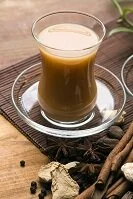Regional Variations, Specialties, & Unique Dishes
Aloo Tama: bamboo shoots prepared with potatoes and served in a spicy curry
Chatamari: naan topped with meat, vegetables, eggs, and anything else
Gundrook-Dheedo: wheat, corn, and vegetables
Masu: meat with a spicy curry served over rice
Momo: meat dumplings often similar to Chinese dumplings, but with Indian spices or sauces
Pulao/Pilaf: rice fried with turmeric, cumin and vegetables
Thukpa: a specially seasoned soup with noodles, vegetables, and often chicken
Dining Etiquette
Before eating in Nepal, you should be aware of some dining commonalities between the Hindus and Buddhists, as most of the people in Nepal adhere to one of these religions. Fortunately, most of these rules pertain to foods that can or cannot be consumed and if eating in the home of a local they simply will not have foods that are forbidden by their religion. If dining out though, be sure to avoid ordering foods your local hosts won't eat. Hindis don't eat beef, while many Hindus and Buddhists are vegetarian so to be safe, order chicken or fish and to be extremely cautious order a vegetarian meal.
You should dress conservatively, meaning your arms and legs should be covered. You should also arrive on time (although food might not be served for a couple hours) and take your shoes off at the door if others do so.
You will likely be asked to wash your hands prior to eating, but sometimes a wash basin is passed around the table so follow the lead of others and let your host show you a seat, which may be on the floor. When seated, be sure to avoid pointing the bottom of your feet at anyone so keep your feet flat on the floor or pointed behind you.
You should try all the foods your host recommends and in some settings this may be a huge number of foods, but take much more rice than anything else as this is meant to be the base. You should also accept more food when offered so try your best to take limited quantities of food at first (a challenge on many occasions). If you take your own food, be sure to avoid touching your plate with the serving spoons as this is considered unclean. Once you have food you may notice there are no utensils (cutlery); this is because you are expected to eat with your right hand and right hand only as the left is considered unclean. You may use naan or rice to scoop the food or to soak up the sauce.
As you finish eating, leave some food on your plate to signify your host has provided more than enough food. If dining in a restaurant the inviter is expected to pay for everyone present. Tipping is not common nor is it expected in Nepal and rarely to never will you encounter a service charge.
Celebrations & Events
Nepal has a growing tradition of local festivals, defined by foods. No matter the festival or occasion, certain foods have become almost synonymous with festivals and celebrations. First among these foods is sel roti, which is a round rice bread most closely associated with the Hindu festival of Tihar, but eaten at other festivals as well. Other popular festival foods include sekuwa, which is goat meat, rice dishes, and more.
Drinks

Masala chai
Like much of the region, the drink of choice in Nepal is tea. The version can differ though as both standard black tea with milk and sugar as well as salted butter tea can be found. Juices and dairy products are also popular beverages, although the juices tend to be very sweet. Soft drinks and coffee are easy to find in any city as well as in some towns and along all major hiking trails foreigners use.
Alcoholic beverages include all the international favorites when you're in a hotel, however in small towns and if you're out and about in a city the selection is limited. However in these out of the way places (especially in the mountains) you'll more likely have the opportunity to try local alcohols like tongba or rakshi, which are both fermented from millet or jard, which is a beer-like drink made from rice.
The tap water is generally not safe to drink in Nepal, but in some mountainous areas it might be safe. The most cautious course of action is to entirely avoid the tap water and items that could be made from or with the water, such as ice, fruits, and salads. If you do decide to drink the local tap water first check with your local hotel or guesthouse to learn the cleanliness of the water in that area. If the water is safe, remember that many people may have trouble adjusting to the local tap water as it will most certainly be different from what your system is used to if you are not from the region.